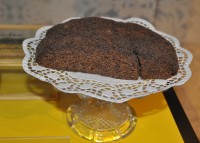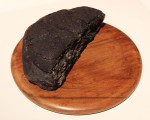 Leaving the 1924 Vanderbilt wedding cake in its dust, a cake baked for 118 years ago for Austria’s Empress Elisabeth, aka Sisi, has gone on display in an Italian castle in Merano, Italy. She wasn’t staying at the castle in September of 1897 when the cake was made. The hardened brown mass that today looks more like the carbonized loafs of bread found at Herculaneum than a cake or tart as we know them was served to Sisi at an inn in the South Tyrolean town of Nals, 10 miles south of the resort town of Merano, then part of the Austro-Hungarian Empire.
Leaving the 1924 Vanderbilt wedding cake in its dust, a cake baked for 118 years ago for Austria’s Empress Elisabeth, aka Sisi, has gone on display in an Italian castle in Merano, Italy. She wasn’t staying at the castle in September of 1897 when the cake was made. The hardened brown mass that today looks more like the carbonized loafs of bread found at Herculaneum than a cake or tart as we know them was served to Sisi at an inn in the South Tyrolean town of Nals, 10 miles south of the resort town of Merano, then part of the Austro-Hungarian Empire.
 This was her fourth visit to Merano. She spent the last decades of her life hopping from health spa to resort town to health spa ostensibly incognito, but of course everyone knew who she was. The Empress was well known as one of Europe’s greatest beauties. When she arrived at the Sonnenwirt inn in Nals, the innkeeper was starstruck. She served her what must have been her prized cake. The Empress, who was famously obsessed with preserving her slim figure, took only the thinnest slice. The innkeeper preserved the rest of the cake in a glass container and it was passed down through the generations.
This was her fourth visit to Merano. She spent the last decades of her life hopping from health spa to resort town to health spa ostensibly incognito, but of course everyone knew who she was. The Empress was well known as one of Europe’s greatest beauties. When she arrived at the Sonnenwirt inn in Nals, the innkeeper was starstruck. She served her what must have been her prized cake. The Empress, who was famously obsessed with preserving her slim figure, took only the thinnest slice. The innkeeper preserved the rest of the cake in a glass container and it was passed down through the generations.
Fanz Mair, the son of the original innkeeper moved just a mile from Merano to the town of Lagundo where he ran and still runs the Kappelgutt guest house. The cake went with him. Franz and Walburga Mair recently decided to donate their family heirloom to the Trauttmansdorff Castle in Merano which is home to the Touriseum, a wonderfully meta museum dedicated to the history of tourism. They wanted the cake to have a more secure home and experts tending to its preservation. They also wanted it to be on public view in a context connected to Empress Sisi’s visits to Merano.
 The Empress stayed at the Trauttmansdorff Castle during two of her four visits to the resort town, the first time in 1870-1, the second in 1889. These weren’t quick stopovers. In 1870, Sisi and her entourage took up multiple rooms on the second floor of the castle for eight months. She was ensconced in the west wings rooms with the greatest views of the bucolic Adige Valley. Her bedroom was the oldest room in the castle with ornamental wooden ceilings and frescoes dating to 1564. Meanwhile, her sickly two-year-old daughter Marie Valerie stayed with her nanny in three rooms in the southeast wing.
The Empress stayed at the Trauttmansdorff Castle during two of her four visits to the resort town, the first time in 1870-1, the second in 1889. These weren’t quick stopovers. In 1870, Sisi and her entourage took up multiple rooms on the second floor of the castle for eight months. She was ensconced in the west wings rooms with the greatest views of the bucolic Adige Valley. Her bedroom was the oldest room in the castle with ornamental wooden ceilings and frescoes dating to 1564. Meanwhile, her sickly two-year-old daughter Marie Valerie stayed with her nanny in three rooms in the southeast wing.
 Sisi’s second stay at the castle was, she would later write, an attempt to recapture the happier days of the first visit. She was in mourning from the death of her son Rudolf in the scandalous murder-suicide at Mayerling just six months before. She occupied the same rooms on the second floor, although this time around the 16th century frescoed room was her dressing room instead of her bedroom. Her intent was stay for months, enjoying the hiking trails and salutary Tyrolean air, but her trip was cut short after six weeks by a terrible storm.
Sisi’s second stay at the castle was, she would later write, an attempt to recapture the happier days of the first visit. She was in mourning from the death of her son Rudolf in the scandalous murder-suicide at Mayerling just six months before. She occupied the same rooms on the second floor, although this time around the 16th century frescoed room was her dressing room instead of her bedroom. Her intent was stay for months, enjoying the hiking trails and salutary Tyrolean air, but her trip was cut short after six weeks by a terrible storm.
It was the Empress’ first visit which really put Merano on the map as a health resort for the rich and titled. Little Marie Valerie recovered quickly from her illness and the word quickly spread about the salutary benefits of a visit to the South Tyrol town. Trauttmansdorff Castle became a magnet for high society and was booked solid for decades. There wouldn’t even be a Touriseum in the castle if it weren’t for Sisi because she’s the one who first made Merano a locus of tourism in the late 19th century, establishing its healthful reputation, appealing to the fashionable crowd and to the multitudes who just wanted to follow in the footsteps of such a huge celebrity.
 Since 2008, the castle has hosted a permanent exhibition dedicated to Sisi in the rooms she once occupied. There are sculptures of her in the beautiful formal gardens she enjoyed during her visits and marked hiking trails for the Empress Sisi fans who still want to walk in her footsteps. Some of her personal belongings — a fan, a parasol, a robe — are on display in the castle. The cake now joins them, a blackened flatbread on a cake stand in a glass display case.
Since 2008, the castle has hosted a permanent exhibition dedicated to Sisi in the rooms she once occupied. There are sculptures of her in the beautiful formal gardens she enjoyed during her visits and marked hiking trails for the Empress Sisi fans who still want to walk in her footsteps. Some of her personal belongings — a fan, a parasol, a robe — are on display in the castle. The cake now joins them, a blackened flatbread on a cake stand in a glass display case.